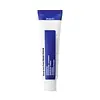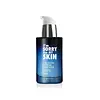What's inside
What's inside
 Key Ingredients
Key Ingredients

 Benefits
Benefits

 Concerns
Concerns

 Ingredients Side-by-side
Ingredients Side-by-side

Sea Water
HumectantDipropylene Glycol
HumectantGlycerin
HumectantWater
Skin ConditioningCaprylic/Capric Triglyceride
MaskingNiacinamide
SmoothingPhenyl Trimethicone
Skin ConditioningCetyl Ethylhexanoate
EmollientCetearyl Alcohol
Emollient1,2-Hexanediol
Skin ConditioningSodium Acrylate/Sodium Acryloyldimethyl Taurate Copolymer
Emulsion StabilisingButylene Glycol
HumectantSodium Hyaluronate
HumectantPanthenol
Skin ConditioningEcklonia Cava Extract
Skin ConditioningLaminaria Japonica Extract
Skin ProtectingCaulerpa Lentillifera Extract
Salicornia Herbacea Extract
Skin ConditioningAllantoin
Skin ConditioningMacadamia Ternifolia Seed Oil
EmollientAdenosine
Skin ConditioningSorbitan Stearate
EmulsifyingSorbitan Oleate
EmulsifyingIsohexadecane
EmollientPolysorbate 80
EmulsifyingGlyceryl Stearate Se
EmulsifyingCarbomer
Emulsion StabilisingArginine
MaskingCaprylyl Glycol
EmollientEthylhexylglycerin
Skin ConditioningDisodium EDTA
Sea Water, Dipropylene Glycol, Glycerin, Water, Caprylic/Capric Triglyceride, Niacinamide, Phenyl Trimethicone, Cetyl Ethylhexanoate, Cetearyl Alcohol, 1,2-Hexanediol, Sodium Acrylate/Sodium Acryloyldimethyl Taurate Copolymer, Butylene Glycol, Sodium Hyaluronate, Panthenol, Ecklonia Cava Extract, Laminaria Japonica Extract, Caulerpa Lentillifera Extract, Salicornia Herbacea Extract, Allantoin, Macadamia Ternifolia Seed Oil, Adenosine, Sorbitan Stearate, Sorbitan Oleate, Isohexadecane, Polysorbate 80, Glyceryl Stearate Se, Carbomer, Arginine, Caprylyl Glycol, Ethylhexylglycerin, Disodium EDTA
Water
Skin ConditioningGlycerin
HumectantDipropylene Glycol
HumectantPolyglycerin-3
HumectantPolyglyceryl-10 Stearate
Skin ConditioningPolyglyceryl-3 Methylglucose Distearate
EmulsifyingBifida Ferment Lysate
Skin Conditioning1,2-Hexanediol
Skin ConditioningButyrospermum Parkii Butter
Skin ConditioningC12-15 Alkyl Benzoate
AntimicrobialCaprylic/Capric Triglyceride
MaskingCyclohexasiloxane
EmollientGlycereth-26
HumectantHydrogenated Poly(C6-14 Olefin)
EmollientNeopentyl Glycol Diheptanoate
EmollientPentaerythrityl Distearate
EmulsifyingHydroxyacetophenone
AntioxidantButylene Glycol
HumectantSodium Stearoyl Glutamate
CleansingEclipta Prostrata Leaf Extract
Skin ConditioningLaminaria Japonica Extract
Skin ProtectingAcrylates/C10-30 Alkyl Acrylate Crosspolymer
Emulsion StabilisingAmmonium Acryloyldimethyltaurate/Vp Copolymer
Parfum
MaskingTromethamine
BufferingXanthan Gum
EmulsifyingAdenosine
Skin ConditioningFructooligosaccharides
HumectantDisodium EDTA
Beta-Glucan
Skin ConditioningCentella Asiatica Extract
CleansingHydrogenated Lecithin
EmulsifyingSaccharomyces Ferment Filtrate
HumectantCarbomer
Emulsion StabilisingHydrolyzed Hyaluronic Acid
HumectantPolysorbate 20
EmulsifyingCaprylyl Glycol
EmollientAcetic Acid
BufferingLactic Acid
BufferingEthylhexylglycerin
Skin ConditioningPalmitoyl Pentapeptide-4
Skin ConditioningAcetyl Hexapeptide-8
HumectantCopper Tripeptide-1
Skin ConditioningHexapeptide-9
Skin ConditioningNonapeptide-1
Skin ConditioningPalmitoyl Tetrapeptide-7
Skin ConditioningPalmitoyl Tripeptide-1
Skin ConditioningTripeptide-1
Skin ConditioningPotassium Sorbate
PreservativeHydrolyzed Lupine Protein
Skin ConditioningWater, Glycerin, Dipropylene Glycol, Polyglycerin-3, Polyglyceryl-10 Stearate, Polyglyceryl-3 Methylglucose Distearate, Bifida Ferment Lysate, 1,2-Hexanediol, Butyrospermum Parkii Butter, C12-15 Alkyl Benzoate, Caprylic/Capric Triglyceride, Cyclohexasiloxane, Glycereth-26, Hydrogenated Poly(C6-14 Olefin), Neopentyl Glycol Diheptanoate, Pentaerythrityl Distearate, Hydroxyacetophenone, Butylene Glycol, Sodium Stearoyl Glutamate, Eclipta Prostrata Leaf Extract, Laminaria Japonica Extract, Acrylates/C10-30 Alkyl Acrylate Crosspolymer, Ammonium Acryloyldimethyltaurate/Vp Copolymer, Parfum, Tromethamine, Xanthan Gum, Adenosine, Fructooligosaccharides, Disodium EDTA, Beta-Glucan, Centella Asiatica Extract, Hydrogenated Lecithin, Saccharomyces Ferment Filtrate, Carbomer, Hydrolyzed Hyaluronic Acid, Polysorbate 20, Caprylyl Glycol, Acetic Acid, Lactic Acid, Ethylhexylglycerin, Palmitoyl Pentapeptide-4, Acetyl Hexapeptide-8, Copper Tripeptide-1, Hexapeptide-9, Nonapeptide-1, Palmitoyl Tetrapeptide-7, Palmitoyl Tripeptide-1, Tripeptide-1, Potassium Sorbate, Hydrolyzed Lupine Protein
 Reviews
Reviews

Ingredients Explained
These ingredients are found in both products.
Ingredients higher up in an ingredient list are typically present in a larger amount.
1,2-Hexanediol is a synthetic liquid and another multi-functional powerhouse.
It is a:
- Humectant, drawing moisture into the skin
- Emollient, helping to soften skin
- Solvent, dispersing and stabilizing formulas
- Preservative booster, enhancing the antimicrobial activity of other preservatives
Adenosine is in every living organism. It is one of four components in nucleic acids that helps store our DNA.
Adenosine has many benefits when used. These benefits include hydrating the skin, smoothing skin, and reducing wrinkles. Once applied, adenosine increases collagen production. It also helps with improving firmness and tissue repair.
Studies have found adenosine may also help with wound healing.
In skincare products, Adenosine is usually derived from yeast.
Learn more about AdenosineButylene Glycol (or BG) is used within cosmetic products for a few different reasons:
Overall, Butylene Glycol is a safe and well-rounded ingredient that works well with other ingredients.
Though this ingredient works well with most skin types, some people with sensitive skin may experience a reaction such as allergic rashes, closed comedones, or itchiness.
Learn more about Butylene GlycolThis ingredient is an emollient, solvent, and texture enhancer. It is considered a skin-softener by helping the skin prevent moisture loss.
It helps thicken a product's formula and makes it easier to spread by dissolving clumping compounds.
Caprylic Triglyceride is made by combining glycerin with coconut oil, forming a clear liquid.
While there is an assumption Caprylic Triglyceride can clog pores due to it being derived from coconut oil, there is no research supporting this.
Learn more about Caprylic/Capric TriglycerideCaprylyl Glycol is a humectant and emollient, meaning it attracts and preserves moisture.
It is a common ingredient in many products, especially those designed to hydrate skin. The primary benefits are retaining moisture, skin softening, and promoting a healthy skin barrier.
Though Caprylyl Glycol is an alcohol derived from fatty acids, it is not the kind that can dry out skin.
This ingredient is also used as a preservative to extend the life of products. It has slight antimicrobial properties.
Learn more about Caprylyl GlycolCarbomer is a polymer of acrylic acid. Its main role is to create a gel consistency.
A high amount of carbomer can cause pilling or balling up of products. Don't worry, most products contain 1% or less of carbomer.
Dipropylene Glycol is a synthetically created humectant, stabilizer, and solvent.
This ingredient helps:
Dipropylene glycol is technically an alcohol, but it belongs to the glycol family (often considered part of the ‘good’ alcohols). This means it is hydrating and gentle on skin unlike drying solvent alcohols like denatured alcohol.
As a masking agent, Dipropylene Glycol can be used to cover the smell of other ingredients. However, it does not have a scent.
Studies show Dipropylene Glycol is considered safe to use in skincare.
Learn more about Dipropylene GlycolDisodium EDTA plays a role in making products more stable by aiding other preservatives.
It is a chelating agent, meaning it neutralizes metal ions that may be found in a product.
Disodium EDTA is a salt of edetic acid and is found to be safe in cosmetic ingredients.
Learn more about Disodium EDTAEthylhexylglycerin (we can't pronounce this either) is commonly used as a preservative and skin softener. It is derived from glyceryl.
You might see Ethylhexylglycerin often paired with other preservatives such as phenoxyethanol. Ethylhexylglycerin has been found to increase the effectiveness of these other preservatives.
Glycerin is already naturally found in your skin. It helps moisturize and protect your skin.
A study from 2016 found glycerin to be more effective as a humectant than AHAs and hyaluronic acid.
As a humectant, it helps the skin stay hydrated by pulling moisture to your skin. The low molecular weight of glycerin allows it to pull moisture into the deeper layers of your skin.
Hydrated skin improves your skin barrier; Your skin barrier helps protect against irritants and bacteria.
Glycerin has also been found to have antimicrobial and antiviral properties. Due to these properties, glycerin is often used in wound and burn treatments.
In cosmetics, glycerin is usually derived from plants such as soybean or palm. However, it can also be sourced from animals, such as tallow or animal fat.
This ingredient is organic, colorless, odorless, and non-toxic.
Glycerin is the name for this ingredient in American English. British English uses Glycerol/Glycerine.
Learn more about GlycerinLaminaria Japonica Extract comes from a kelp more commonly known as 'sweet kelp'. It is commonly eaten in Japan, Korea, and China.
Sweet kelp is a humectant and helps hydrate your skin. Humectants draw moisture from the air to your skin.
Studies show Laminaria Japonica has antioxidant compounds. Antioxidants may help with anti-aging. Kelp also contains magnesium and zinc, making it great for calming inflammation and redness.
Learn more about Laminaria Japonica ExtractWater. It's the most common cosmetic ingredient of all. You'll usually see it at the top of ingredient lists, meaning that it makes up the largest part of the product.
So why is it so popular? Water most often acts as a solvent - this means that it helps dissolve other ingredients into the formulation.
You'll also recognize water as that liquid we all need to stay alive. If you see this, drink a glass of water. Stay hydrated!
Learn more about Water